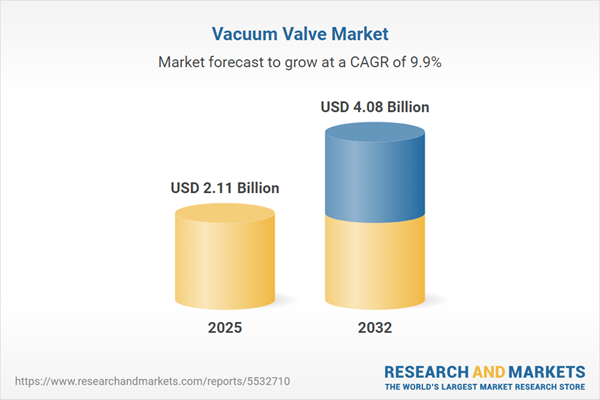Speak directly to the analyst to clarify any post sales queries you may have.
The vacuum valve market is entering a critical phase as technology innovation, operational resilience, and regulatory requirements reshape its trajectory. Companies are under pressure to optimize product portfolios and align sourcing strategies, all while addressing an increasingly complex global environment. Senior leaders need clear, actionable insights to remain competitive in this evolving sector.
Market Snapshot: Vacuum Valve Market Size and Growth
Driven by advancements in industrial manufacturing and ongoing digital transformation, the vacuum valve market expanded from USD 1.92 billion in 2024 to USD 2.11 billion in 2025. Projections indicate continued robust growth at a CAGR of 9.85%, reaching USD 4.08 billion by 2032. Market expansion is propelled by strengthened demand from the semiconductor, petrochemical, aerospace, and healthcare industries, each requiring precise control solutions and reliable vacuum infrastructure for critical operations.
Scope & Segmentation: Technology, Application, and Regional Overview
- Valve Types: Includes ball valves (floating and trunnion), butterfly valves, check valves, gate valves (nonrising and rising stem), and globe valves (angle and straight types). These cater to a range of control and sealing requirements.
- Actuation Methods: Electric, hydraulic, manual, and pneumatic systems (air to close, air to open) are featured to meet both automation and operational flexibility needs.
- End Uses: Serve diverse sectors such as chemicals and petrochemicals, healthcare, oil and gas, power generation, and semiconductor manufacturing—each influencing performance and qualification standards.
- Materials: Key options are aluminum, brass, plastic, and stainless steel, selected for durability, chemical compatibility, and cost considerations.
- Pressure Ratings: Classified by high vacuum, low vacuum, and ultra high vacuum, shaping requirements for sealing, surface finish, and application suitability.
- Regions Covered: Analysis includes Americas (North and Latin America), Europe, Middle East & Africa, and Asia-Pacific. Regional focus highlights supply chain adaptability and technology adoption tailored to local market drivers.
- Company Analysis: Leading players profiled include VAT Group AG, MKS Instruments, Inc., Pfeiffer Vacuum Technology AG, ULVAC, Inc., Atlas Copco AB (publ), and Brooks Automation, Inc.
Key Takeaways for Decision-Makers
- Advanced technologies such as additive manufacturing and digital monitoring are accelerating the development of next-generation vacuum valves, enabling improved lifecycle management and system uptime.
- Regulatory shifts, especially in environmental and safety frameworks, are influencing design priorities—driving adoption of sustainable materials and lean production methods across the industry.
- Cross-industry partnerships are encouraging the integration of smart valve systems, blending mechanical robustness with software-based analytics for proactive maintenance and remote operation.
- Regional distinctions remain central: North America sees manufacturing capacity expansions, Europe emphasizes compliance innovation, Asia-Pacific drives scale through a strong technology base, and the Middle East focuses on reliability for oil and gas applications.
- Portfolio strategies account for segmentation dynamics; selecting valve type, actuation, and material combinations to address unique operational and lifecycle demands from diverse market verticals.
Tariff Impact on Supply Chains and Manufacturing
The introduction of United States tariffs in 2025 significantly altered global sourcing and value chains within the vacuum valve market. Companies reliant on international components experienced pressure on margins, prompting a shift toward domestic production capabilities and regional supplier diversification. This transition has triggered new partnerships, nearshoring initiatives, and design modifications based on locally available materials—resulting in enhanced supply chain transparency and the emergence of regional manufacturing clusters.
Research Methodology & Data Sources
Market intelligence is developed through a combination of in-depth interviews with industry executives and comprehensive review of technical documents, white papers, and regulatory filings. Analytical frameworks, including value chain mapping and case study analysis, support validation. Subject-matter expert reviews and quantitative data triangulation ensure reliability and actionable quality.
Why This Report Matters
- Delivers targeted, executive-level insights on market drivers, competitive positioning, and supply chain strategies—enabling rapid strategic decision-making.
- Deep segmentation and regional analysis equip stakeholders to identify opportunities, anticipate regulatory impacts, and tailor go-to-market initiatives to specific application environments.
- Supports resilience planning by detailing responses to tariff shocks and highlighting best practices in digital innovation and sustainability.
Conclusion
The vacuum valve market is charting a path toward greater innovation, operational agility, and regional adaptation. This report provides the essential intelligence senior leaders need to secure enduring relevance, drive value creation, and anticipate change in a complex global landscape.
Additional Product Information:
- Purchase of this report includes 1 year online access with quarterly updates.
- This report can be updated on request. Please contact our Customer Experience team using the Ask a Question widget on our website.
Table of Contents
3. Executive Summary
4. Market Overview
7. Cumulative Impact of Artificial Intelligence 2025
Companies Mentioned
The companies profiled in this Vacuum Valve market report include:- VAT Group AG
- MKS Instruments, Inc.
- Pfeiffer Vacuum Technology AG
- ULVAC, Inc.
- Atlas Copco AB (publ)
- Brooks Automation, Inc.
Table Information
| Report Attribute | Details |
|---|---|
| No. of Pages | 186 |
| Published | October 2025 |
| Forecast Period | 2025 - 2032 |
| Estimated Market Value ( USD | $ 2.11 Billion |
| Forecasted Market Value ( USD | $ 4.08 Billion |
| Compound Annual Growth Rate | 9.8% |
| Regions Covered | Global |
| No. of Companies Mentioned | 7 |








